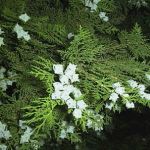| Common Name: |
Cedar |
| Other Names: |
American Arbor Vitae, Arbor-Vitae, Cedar Leaf, Eastern White Cedar, Swamp Cedar, Thuja, Tree of Life, Yellow Cedar |
| Botanical Name: |
Thuja occidentalis |
| Genus: |
Thuja |
| Family: |
Cupressaceae |
| Native Location: |
Eastern N America |
| Cultivation: |
Deep, moist, well-drained soil in sun. Dislikes cold, drying winds when young. Trim hedges in spring and late summer. Trees may be damaged by scale insects, aphids, canker, and Keithia disease. |
| Propagation: |
By seed sown in late winter (species only); by semi-ripe cuttings in late summer. |
| Harvest: |
Foliage and bark are removed as required and dried for use in decoctions, liquid extracts, and tinctures. Seeds (T. orientalis) are collected from ripe cones in autumn and dried for use in decoctions, powders, and tinctures. |
| Variants: |
Holmstrup
Is dense and conical tree with rich green foliage, held vertically.
Height: 3-4m (10-12ft) |
Rheingold
Has old-gold foliage, pinkish when young, which bronzes in winter.
Height: 1-2m (3-6ft) |
Smaragd
Is compact and dwarf, with bright green foliage.
Height: 1m (3ft)
Width: 80cm (32in) |
|
| Height: |
10-20m (30-70ft) |
| Width: |
3-5m (10-15ft) |
| Hardiness: |
Z2-9 |
| Parts Used: |
Foliage, bark, leaf, oil of the leaf. |
| Chemical Constituents |
Fenchone
Pinopicrin
Tannins
Thujone
Volatile Oils
|
| Properties: |
A bitter, astringent, cooling herb with a camphoraceous, fruity aroma. It stimulates the heart, uterus and nerves, reduces inflammation, clears toxins, and is diuretic, expectorant, anti-fungal, and anti-viral. |
| Medicinal Uses: |
Internally in cancery therapy and for bronchial complaints (especially associated with congestive heart failure), urinary infections (including cystitis), bed-wetting in children, psoriasis, eczema, failure to menstruate. Once used to treat side effects of smallpox vaccinations. Externally for vaginal infections, warts, muscular aches, and rheumatism. Combined with Hamamelis virginia (See, Common Witch Hazel) as a lotion for exudative eczema.
Tro treat respiratory tract infections, arthritis, bacterial skin infections, and herpes simplex. |
| Known Effects: |
Stimulates central nervous system
Stimulates heart muscle to contract more efficiently
Destroys intestinal worms
Causes uterine contractions
Interferes with the absorption of iron and other minerals when taken internally
Miscellaneous Information:
Yellow cedar has caused deaths when misused to induce abortions.
|
| Possible Additional effects: |
May relieve muscular aches and pains
May treat warts
May cause abortions (miscarriages)
|
| Warnings and Precautions: |
Leaves are toxic if eaten.
Skin allergen.
Contraindicated during pregnancy and in dry, irritant coughs.
For use by qualified practitioners only.
Don't take if you:
Are pregnant, think you may be pregnant, or plan pregnancy in the near future.
Consult your doctor if you:
Take this herb for any medical problem that doesn't improve in 2 weeks (There may be safer, more effective treatments.)
Take any medicinal drugs, or herbs including aspirin, laxatives, cold and cough remedies, antacids, vitamins, minerals, amino acids, supplements, other prescription or non-prescription drugs
Pregnancy:
Dangers outweigh any possible benefits. Don't use.
Breastfeeding:
Dangers outweigh any possible benefits. Don't use.
Infants and Children:
Treating infants and children under 2 with any herbal preparation is hazardous.
Others:
Dangers outweigh any possible benefits. Don't use.
Storage:
Store in a cool, dry area away from direct light, but don't freeze
Store safely out of reach of children
Don't store in bathroom medicine cabinet. Heat and moisture may change the action of the herb
Safe Dosage:
Consult your doctor for the appropriate dose for your condition.
|
| Typical Dose: |
A typical dose of cedar leaf may range from 2 to 4 ml of liquid extract (no specified concentration). |
| Possible Side Effects: |
Cedar leaf's side effects include asthma, seizures, nausea, and painful diarrhea. |
| Drug Interactions: |
| Taking cedar leaf with these drugs may increase the risk of seizures: |
| Acetazolamide,(Apo-Acetazolamide, Diamox Sequels) |
Amobarbital,(Amytal) |
Arbamazepine,(Carbatrol, Tegretol) |
Barbexaclone,(Maliasin) |
| Clonazepam,(Klonopin, Rivotril) |
Clorazepate,(Tranxene, T-Tab) |
Diazepam,(Apo-Diazepam, Valium) |
Ethosuximide,(Zarontin) |
| Felbamate,(Felbatol) |
Fosphenytoin,(Cerebyx) |
Gabapentin,(Neurontin, Nu-Gabapentin) |
Lamotrigine,(Lamictal) |
| Levetiracetam,(Keppra) |
Lorazepam,(Ativan, Nu-Loraz) |
Mephobarbital,(Mebaral) |
Methsuximide,(Celontin) |
| Oxazepam,(Novoxapam, Serax) |
Oxcarbazepine,(Trileptal) |
Pentobarbital,(Nembutal) |
Phenobarbital,(Luminal Sodium, PMS-Phenobarbital) |
| Phenytoin,(Dilantin, Phenytek) |
Primidone,(Apo-Primidone, Mysoline) |
Thiopental (Pentothal),() |
Tiagabine,(Gabitril) |
| Topiramate,(Topamax) |
Valproic Acid,(Depacon, Depakote ER) |
Vigabatrin,(Sabril) |
Zonisamide,(Zonegran) |
|
| Disease Interactions: |
May irrigate the gastrointestinal tract and worsen gastrointestinal ailments. |
| Supplement Interactions: |
Increased risk of thujone toxicity when taken with herbs containing thujone, such as Oak Moss, Oriental Arborvitae, Sage, Tansy, Tree Moss, and Wormwood. |
| Adverse Reactions, Side Effects or Overdose Symptoms: |
| Signs and Symptoms |
What to do |
|
| Abortion |
Seek emergency treatment |
| Coma |
Seek emergency treatment |
| Convulsions |
Seek emergency treatment |
| Precipitous blood pressure drop: symptoms include faintness, cold sweat, paleness, rapid pulse |
Seek emergency treatment |
|
| Bibliography: |
The Encyclopedia of Herbs by Deni Bown Copyright © 1995, 2001 Dorling Kindersley Limited. Pp. 386-387.
The Essential Herb-Drug-Vitamin Interaction Guide by Geo. T. Grossberg, MD and Barry Fox, PhD Copyright ©2007 Barry Fox,PhD, Pp. 137-138
Vitamins, Herbs, Minerals & Supplements The Complete Guide By H. Winter Griffith Copyright©1988 Fisher Books pp. 469-470 |
